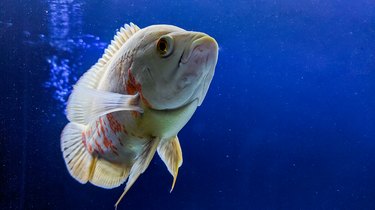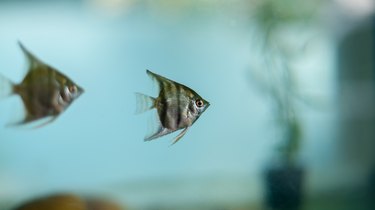Cichlids add a touch of dramatic beauty to your freshwater aquarium, but it's important to choose the correct size and population for your tank conditions. There are more than 1,600 varieties of cichlids, ranging from just a couple inches long to almost 2 feet. Larger cichlids tend to grow faster during the first few months of life — up to an inch per month — and then slow down until they reach maturity.

Video of the Day
Dwarf cichlids for smaller tanks
The species that can be considered to be "dwarf" cichlids will still grow to be about 4 to 5 inches long. These cichlids are well suited for smaller tank setups. However, some of these smaller cichlids will exceed their maximum size if given plenty of room, good nourishment, and excellent water conditions.
Video of the Day
Discus fish can be kept in aquariums as small as 7 gallons to start. These small cichlids will only be about an inch long when you get them but will reach their full growth of 4 inches within the first six months of life. Be prepared to provide about 10 gallons of tank space per fish when they are mature. Angelfish, on the other hand, need a 20-gallon tank for a pair and grow a little less rapidly. They'll top out at about 6 inches, but they won't reach full size until they are over a year old.
Other small species include the convict cichlid, which reaches 6 inches at maturity. They will grow about 4 inches in the first year or so of life and not reach full size until about 5 years old. Despite their small size, their aggressive nature makes them best for 40-gallon tanks. The more peaceful Bolivian ram cichlid stays around 3.5 inches and achieves full growth in about three months but only lives about four years in ideal conditions.

Prepare for rapid growth
Some cichlids grow so rapidly in the first few months of life that you might be tempted to panic about not having a large enough tank. Bolivian ram cichlids, for example, can sprout up to 3 inches in their first two months of life. Their growth then levels off until they reach their full 6-inch length at about 10 months old.
Oscars are one of the fastest-growing cichlids, growing an average of an inch a month for the first 10 or so months of life. Although they are not the largest cichlid, they need to have the most room because of their hyperaggressive temperament. Fifty gallons for one fish is minimum. Seventy to 80 is better and will reduce the stress this fish feels in confined quarters.
Jack Dempsey cichlids are also notable overachievers in the early growth department. They rocket to around 5 inches long during their first four months. The growth slows until they reach 10 inches at about 10 months old. Although they are not aggressive, they are territorial, so make sure this fish has at least a 55-gallon community tank so he can stake out some space of his own.
Encouraging cichlid growth
You can check a New World or African cichlid fry growth chart to determine which species is right for your tank conditions. This will also let you know how quickly you can expect your fish to reach full size.
Proper tank conditions are essential to helping your pet fish reach her growth potential and life expectancy. Replicate your cichlid's natural conditions as closely as possible. For many types, this means a pebbly substrate and plenty of rock caves in which to hide.
Water with low nitrates is essential to facilitating rapid growth. Quality filtration and frequent water changes are key to reducing toxins that not only stunt growth potential but stress cichlids, making them act more aggressively. Feed your fish high-quality food but don't overfeed or you'll increase the level of tank nitrates and slow their growth.